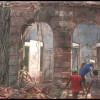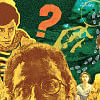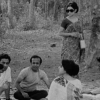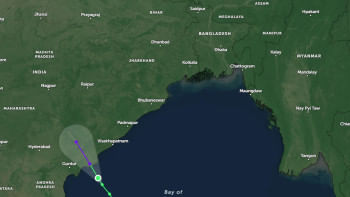From ‘Feluda’ to ‘Derry Girls’: Why we seek out fictional places

Why do we seek out places we've only experienced through fiction? What compels us to wander the streets where our favourite characters "lived" or visit landmarks tied to a story that moved us? For me, this way of traveling is something my father passed down. He believed in exploring the world through the lens of stories and artistes he admired. From visiting spots that inspired writers to finding film locations, he taught me that travel can be more than sightseeing; it can be about finding connection. And now, following those footsteps, I find myself seeking out places that are as real in my mind as they are on a map.
Over the years, I've come to appreciate both the magic and the challenges of this kind of journey. There's a certain thrill to stand in a place that once only existed in a book or on screen– like you're stepping into a world that shaped your imagination. Yet, sometimes the vision we create doesn't quite match reality. The charm can feel diluted by commercialisation, or the setting doesn't evoke the same emotions we anticipated. But for every over-hyped landmark or crowded souvenir shop, there are those fleeting, magical moments when fiction and reality blend seamlessly, and you feel part of the story. Those moments make the journey worthwhile every time.

One of my earliest adventures into culture-based tourism was following the trail of Feluda in Kolkata, tracing the steps of Satyajit Ray's famous detective. Since organised culture-based tourism wasn't really a thing in this part of the world, I had to piece together the trail on my own. Armed with a love for Ray's work and a rough plan, I set off to explore the places that had shaped Feluda's world. I started with what is supposed to be Feluda's home—21 Rajani Sen Road, Ballygunge. Except, well, it didn't exist. I walked up and down the road, squinting at house numbers, like I was in my own mystery, only to find that I'd misjudged my expectations. But I ended up telling myself, "the magic of these journeys often lies in the missteps."
Things picked up when I arrived at the historic Park Street Cemetery, one of Kolkata's oldest landmarks. This place, with its haunting beauty, has served as the backdrop for one of Feluda's cases in "Gorosthaney Shabdhan". And standing there, I realised just how authentically Ray had captured its atmosphere. The towering tombstones, overgrown trees, and quiet desolation felt exactly as he had described—dark, mysterious, and tinged with history. Even the mosquitoes Jatayu had complained about in the story were very much present, making me wonder if the municipality's lack of upkeep was intentional. You really can't buy this kind of 'authentic' experience!

Then there was Satyajit Ray's house on Bishop Lefroy Road. Since it's still a family home, I only planned to have a peek from the outside. The house, itself, was an elegant colonial building, with pale yellow walls and wooden shutters that seemed to whisper stories from a quieter time. The street was casual and unassuming, with a few regular passersby, seemingly indifferent to the building's history. Yet, it held a quiet charm– Victorian-style lampposts lined the road, each one adorned with a poster of Ray's iconic films. Some posters were torn, colours faded, but that only added to the feeling that I was seeing something real, something lived in.

It wasn't a polished tourist attraction, but rather a piece of living history, worn around the edges yet still alive. As I stood there, a group of locals caught my eye, sitting on the footpath in a circle, deeply engrossed in a card game. It instantly reminded me of a sketch by Ray from "Bospukure Khunkharapi", where the three musketeers play cards on the footpath, keeping an eye on a crime scene. In that moment, fiction and reality blended effortlessly. It wasn't the grand, polished experience I'd imagined, but it was something intimate, alive, and unexpectedly beautiful. For a fleeting moment, it felt like I had entered a quiet corner of Ray's world.

Notting Hill in London, though, isn't as unassuming as Bishop Lefroy Road in Kolkata. Unlike the quiet, almost untouched charm outside Satyajit Ray's home, Notting Hill fully embraces its fame and capitalises on it. I'd pictured it as an idyllic neighbourhood with colourful houses, quirky shops, and a romantic, carefree vibe straight from the film. But in reality, it was something else entirely. Portobello Road, so quaint and charming on screen, was packed wall-to-wall with tourists. The market stretched endlessly with vendors selling everything from vintage clothes to old records, quirky antiques, and handmade jewellery. Street performers filled the air with music, mingling with the smells of street food, as crowds bustled through, laughing, bargaining, and crowding every stall. There was a sense of excitement, almost like a festival, but it was far from the neighbourhood feel I had imagined. Notting Hill had become a destination now, one that rarely sleeps on weekends.

The famous blue door was barely visible behind the throngs of people snapping photos. A few locals brushed by, casting side glances as they tried to navigate through the crowd. I could see why it might be frustrating—to have your daily life interrupted by tourists lining up to photograph what, to locals, was simply another door. It made me think about how the residents' sense of place must feel tested by the constant flow of people eager to claim a piece of their home. The commercialisation was undeniable, with souvenir shops cashing in on the film's popularity, selling "Notting Hill"-themed trinkets, mugs, and postcards. A few streets away, I found the shop that inspired William Thacker's bookstore in the film. Once an independent spot known as The Travel Bookshop, this cozy shop on Blenheim Crescent had charmed director Roger. Established in 1979, it specialised in travel literature until it closed in 2011. Later revived by The Book Warehouse under the name The Notting Hill Bookshop, it no longer solely sells travel books but retains a nostalgic charm, packed with shelves, souvenirs, and a small plaque honouring its role in the film's legacy. Standing there, I felt the quiet authenticity Michell must have loved: a slice of London's past mingling with the magic of cinema.
As I continued walking through Notting Hill, I couldn't help but notice signs of local discontent. Graffiti near the famous blue door read, 'tourists are sheep' and 'tourists suck.' For the residents, fame had turned their neighbourhood into a spectacle, where their daily lives clashed with the expectations of fans drawn to a romanticised version of the place. I left Notting Hill with a new perspective. It reminded me that while fame can put a place on the map, it can just as easily transform it.

One of my favourite experiences was visiting Cortona, Tuscany, the town I'd fallen in love in my teenage years through the film "Under the Tuscan Sun". Watching the movie and later reading Frances Mayes' book had me dreaming of escaping to this warm Italian paradise, with its rolling hills, bowls of pasta, rustic villas, and slower pace of life. I still vividly recall the scene where Diane Lane walks through the sun-drenched streets, and suddenly, I was doing just that. Just like in the film, Cortona was a small, charming Tuscan village with a timeless beauty and a piazza at its heart. Unlike the bustling, camera-clicking atmosphere of Notting Hill, Cortona had embraced its connection to the film without losing its authenticity. Here, people spoke of the author, the book and the movie like an old friend. Café owners and shopkeepers casually mentioned how 'lovely' Diane Lane was, spinning stories from the filming as if it had happened just last week. One café owner swore Diane had complimented his espresso, and he's been serving it the same way ever since. Another shopkeeper grinned, saying the director was a 'gentle soul' with a great eye for choosing wines. They treated the film crew like family, and it was clear the whole experience had left a mark on the town, just not in a commercial way. The cobbled streets lined with family-run trattorias, hand-painted ceramics shops, and flower-filled balconies felt like stepping back in time. Locals greeted each other with such warmth that it felt like a slice of Italian life that hadn't changed in decades. In the piazza, friends caught up over espresso, children chased pigeons, and life moved at a relaxed pace, as if the town itself had all the time in the world.

With the help of a local woman named Ana, I made my way up to Villa Bramasole, the very villa that inspired Frances Mayes to write her book and where she lives now in summer. Perched on a hillside just outside town, the villa was exactly as I'd imagined: yellow walls, lush ivy, archways looking out over olive groves and vineyards. It was every bit the dream that Mayes had painted. Standing there, I could completely see why she fell in love with the place, and for a moment, it felt like I had stepped into her story or maybe she had written it into mine. Cortona didn't just match the story and frames, it somehow made all of it even better.
Very recently, I have started living in Derry, Northern Ireland, for my PhD and again I'm discovering how profoundly a place can be shaped by popular culture. This city, steeped in rich history, served as the backdrop for "Derry Girls", a show that has resonated with so many. Before moving here, the show wasn't even on my radar, but now it's impossible to miss. Every day, as I stroll through the city, I pass by tourists gathering around the iconic "Derry Girls" mural, snapping photos and laughing as they reenact their favourite scenes. Even my colleagues at the university can't stop referencing the show, quoting characters and reminiscing about memorable moments. Their enthusiasm is infectious, and almost out of FOMO, I started watching it last month. And after a few episodes of "Derry Girls", I began to see the city through a new lens. As I walked Derry wall, I couldn't shake the feeling that I was walking through a living scene from the show. The familiar accents of locals now remind me of the beloved characters I had just started to know.

Recently, I visited a quaint bookstore in my neighbourhood. And with a twinkle in his eye, the old bookseller asked me, "Did ya know the last scene of 'Derry Girls' was shot right here? Aye, right in this very spot!" I promised him I'd finish the show soon and find that scene filmed in his shop. It struck me as fascinating that a Netflix show often celebrated by young women had captured the heart of this old local man as well. When I asked him why he loved "Derry Girls", he simply replied, "It's our story, told by our girl, aye? How could I not love it?"
Even with my limited insight, I can see what he is talking about. Here, people truly look like the characters portrayed in the show, their accents ring true, and their humour strikes a familiar chord. Conversations about saving up for a night out or carrying a punt purse are real exchanges that fill the air. The show captures the essence of life in Derry, weaving together the ordinary and the extraordinary in a way that feels both relatable and heartfelt. The city has also wholeheartedly embraced its connection to the show in wonderful ways. They've even created a small museum filled with props and memorabilia from "Derry Girls", where fans can revel in the authenticity of the production. Places where iconic scenes were filmed are lovingly commemorated around the city and tours with small groups are often arranged to visit these spots. There's a palpable warmth behind these efforts, a celebration of the show's impact on the community that feels genuine and heartfelt. Despite the commercialisation, it's done with such affection for the show and its representation of Derry's spirit.

Reflecting on my travels to all these places has made me realise a profound truth about cultural tourism or maybe tourism in general. It is, undeniably, a double-edged sword. On one side, there's an exhilarating joy in sharing the stories we cherish and connecting with fellow travellers and locals who resonate with those narratives. These moments forge bonds that transcend geographical boundaries, reminding us that we are part of a larger human experience. Yet, on the other side, there's an inherent risk of losing the very charm that makes these places special.

When locations become overrun with tourists or overly commercialised, the authenticity that once captivated our imaginations can fade, leaving behind a hollow echo of what was once vibrant. This tension between genuine connection and commercialisation is something I've witnessed in every place I've explored, from the bustling streets of Notting Hill to the quaint corners of Cortona. To preserve the charm of these beloved locations, it's obviously essential for communities to strike a balance between welcoming visitors and maintaining their unique character. This might involve limiting the number of tourists in certain areas, promoting local businesses that emphasise authentic experiences, or encouraging sustainable tourism practices that respect the community and environment. Additionally, engaging locals in storytelling, allowing them to share their own narratives and insights can deepen visitors' understanding of a place and enhance the overall experience for everyone involved too.
Despite these imperfections and challenges, I believe places like these hold a special kind of magic, a tangible link to the stories we love. So, I'll just keep exploring with an open-heart. I will continue to lookout for those moments where stories come to life, where reality brushes up against the extraordinary, and where I can relish the thrill of being part of a shared narrative.
The author is a lecturer at the University of Liberal Arts Bangladesh (ULAB). She is currently pursuing her PhD degree in Cinematic Arts at Ulster University.

 For all latest news, follow The Daily Star's Google News channel.
For all latest news, follow The Daily Star's Google News channel. 








Comments